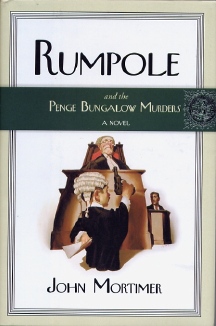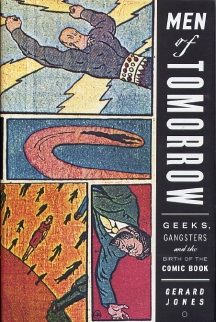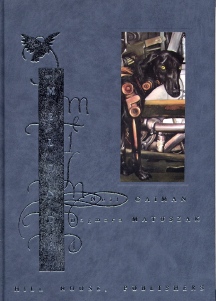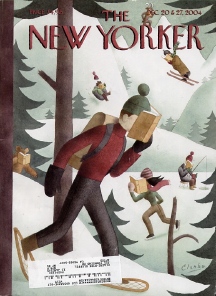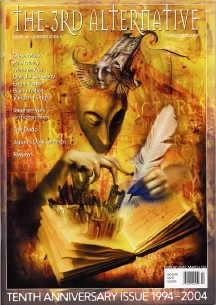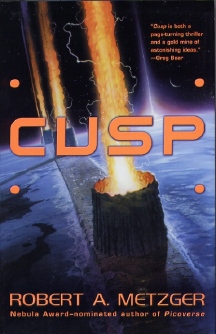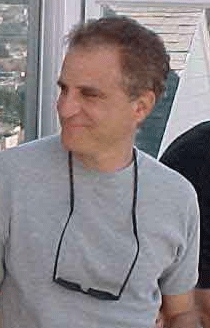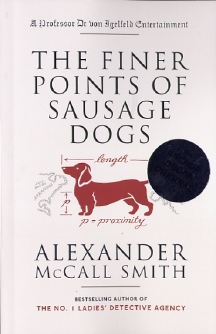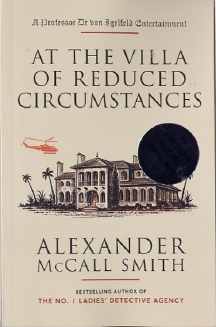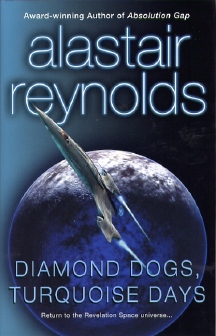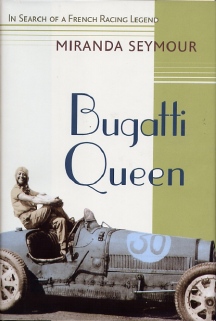|
|
|
This Just In...News from the Agony Column
|
12-23-04: Upcoming Column and Book Give-Away; 'Men of Tomorrow' by Gerard Jones; Hill House + Neil Gaiman + Dagmara Matuszak = Melinda |
|||
The
Non-Fiction Adventures of the Men Who Invented Comics
One of the big pieces to fall into place was the arrival of 'Men of Tomorrow' by Gerard Jones (Basic Books / Perseus Books ; October 30, 2004 ; $26.00). One of the most interesting things to me about the world of graphic novels is the world of graphic novels and those who design them. Of course, this was covered in Pulitzer Prize style fiction by Michael Chabon in 'The Amazing Adventures of Kavalier and Clay'. 'Men of Tomorrow: Geeks, Gangsters and the Birth of the Comic Book' offers the real-life analog of these bigger-than-life characters. Two pairs dominate the early portions of the book --two boys, Jerry Siegel and Joe Shuster, the geeky kids who created Superman, and two men, Harry Donenfeld and Jack Liebowitz. Shuster and Siegel were cousins. There were the creative minds behind Superman, their fantasy of power and good that conquered minds for the next two generations -- and beyond. Donenfeld was a pornographer and a bootlegger, while his partner Leibowitz was a one-time socialist who had converted to the virtues of hardcore capitalism. The artists and businessmen met -- and the rest is a glorious, messy, slightly insane history, ably unfurled in the expert hands of Gerard Jones. Jones is not just an academic, plucking up papers from the archives. He's a two-fisted comics geek extraordinaire, who's written for Superman, Batman, Spiderman and the Shadow -- the holy trinity of comics plus one. He also serves as part of the 826 Valencia Street Project run by McSweeney's. That suggests we have an artist and a capable technician in charge of our non-fiction history. Which is precisely what we want. As I start to read more and more graphic novels -- yes, I've finished two and I'm about to start on my third -- see the article below -- knowing where the whole genre came from seems like a good idea to me. Moreover, this seems like an exciting slice of history filled with two types of people I really enjoy reading about -- oddball artists and eccentric businessmen. Were one to ask for a nutshell description of the publishing world in general, I suspect that might come close. |
|||
More
Than A Graphic Novel
But back to this Gaiman / Matuszak deal. Readers expecting the usual graphic novel will be surprised to find something rather different -- something more than a graphic novel and, more to the point as far as this highly opinionated reader is concerned -- something more novelistic, but simultaneously, something more graphic as well. Readers should take close note of how I've paired superstar Gaiman with Matuszak. That's because you're going to hear a lot more from the two of them, and because Matuszak contributes not just amazing art --as you can see from the cover -- but also, amazing design. And for Hill House, this once again reaches a new level of sublime artistic publishing. But if I tell you any more then I'll have to shoot me. And then, who is going to box up the books that I'm planning on sending to the winners of that contest? |
|
12-22-04: The Periodic Table of Periodicals |
||||||
The
New Yorker Fiction Issue and The Third Alternative Tenth Anniversary
Issue
Having plugged them back in I checked and yes, what I saw on the cover was correct. Special Fiction Issue. A. M. Homes. Dave Eggers. Hanna Krall. The late W. G. Sebald. Ian McEwan. Robert P. Jones. Chris Ware. Robert Lovell. Monty Python. Sort of to-die-for. Sort of. Take a look inside before you buy it. Oh wait you can't -- it's wrapped up. Better hope some Internet columnist picks it up and dishes the dirt. Because what you see ain't exactly what you get. Dave Eggers writes about Monty Python. A. M. Homes offers a memoir. W. G. Sebald writes an essay. Now, I'm not denigrating any of the writing within. Dave Eggers on Monty Python is pretty riveting stuff. Nowhere else will you read that Elvis was a Monty Python fan, constantly quoting (naturally, in hindsight), the "Nudge, nudge, wink, wink" skit. And a memoir from A. M. Homes is simply more great writing from A. M. Homes. It's actually as riveting and emotional as her fiction -- perhaps more so. W. G. Sebald's essay or memoir --take your pick -- is also a powerful stuff. But they're not fiction. Still, the fiction you do get is pretty great stuff. Translated from the Polish by Madeline G. Levine, Hanna Krall, though she specializes in non-fiction, offers a powerful little tale of a free-living couple of artists in Nazi Germany who take in a Jewess in 1943. She becomes pregnant. Story follows -- compelling, gripping stuff. Ian McEwan is one of our finest writers, and Edward P. Jones just won a Pulitzer Prize for 'The Known World'. And amazingly enough, Chris Ware gets four four-color pages to do his peculiar 'Situation Comedy' -- 'Dick Public in Gettin' some culture'. And no, Dick does not buy a copy of The New Yorker to do so. Fortunately for the shreds of my tiny brain, the New Yorker seems to have recovered something in the cover game. In fact, I have to confess that I love this cover. I'm further forced to admit that I might be the person pictured on the cover. Does anybody else besides me enjoy going to some beautiful lookout point over the ocean, or in the midst of a forest, or on a mountaintop -- and then breaking out a book to read? If you think about it -- and I try not to, it's best not to, but let's engage in some dangerous thoughts -- if you think about it, it's a very perverse inclination. When one is in the midst of great natural (or even man-made) beauty, what impulse leads one to stick one's head in a book? Why are these lookouts so appealing to readers? Perhaps it's just me. Surrounded by the vastness of nature, I think it's just a little easier for me to build the book's world inside my brain. All that gorgeousness just fades into a perfect drone, and then I can go about manufacturing whatever it is that I'm reading about. I guess. I'm still not sure. But one thing I know. In the New Yorker's Fiction issue -- the fiction starts on the cover.
Well, perhaps it's the no-nonsense, (for the most part) black-on-white super-easy-to-read layout. The illustrations within are very cleanly popped in to the story and for this reader, add a compelling "read-me" to the proceedings, though at this point, I've not read any. That said, I'm particularly intrigued by 'Black Static' by Paul Meloy. Credit the illustrations by Ben Baldwin. Steve Mohn steps over from Interzone to contribute 'We Must An Anguish'. In his regular column 'Electric Darkness' Steven Volk asks -- and entertainingly answers -- the old horror question "Why do you like such horrible things?" Other non-fiction articles include an interview with Clive Barker, John Paul Catton's take on the dark sides of Japanese culture, an interview with comic book artist Bryan Talbot, and a wonderful selection of book reviews from Peter Tennant. The selection of fiction is rounded out by Darren Speegle, David J. Schwartz, 'The Cajun Knot' by Melanie Fazi translated by Brian Stableford, 'Thirst' by Vandana Singh and 'Running on Two Legs' by Eugie Foster. Don't think I've forgotten 'The Dodo Has Landed' the enjoyably weird musings of Allen Ashley. In summary -- page upon page of eminently readable fiction, nicely printed in a large, lay-down format. Let's not forget either, how this all begins, with an editorial by Nicholas Royle, selected after much hemming and hawing on the TTA BBS. Tenth ann |
|
12-21-04: On the 'Cusp' of Understanding; Richard Wolinsky Makes 'Bookwaves' |
||||||
Robert
Metzger's Distributed Future
Now, on one hand, 'Cusp' -- which I have to like because it mirrors the call letters of the radio station that broadcasts my interviews, KUSP -- looks like a pretty thick book. It's 517 pages. But it's a small format, 5 1/2" by 8 1/4", with readably sized type, so perhaps it's not all that long. While I don’t really look forward to reading electronic books -- I suppose I will have to eventually -- as a reviewer, I'd love to have them. That way, I could search ("grep", as we in the UNIX sysadmin world call it) for characters' names and specific incidents so that I could write more informed reviews more quickly. Readers don't know how much time I spend while writing reviews, paging through books looking for this and that to make sure that I get stuff right. Damn, especially last names. I feel like such a maroon when I don’t remember, and have to page through frantically, relying on my sieve-like memory as to where something happens. In the case of the Metzger novel, I could also grab a word count, to give me a better idea just how long it actually is.
Clues are in abundance in the post-Rings world of Robert Metzger. Man is trying to hurry up to become post-human with cybernetic implants all the rage. The men who first saw the flare erupt -- General Thomas Sutherland and Dr. Jesper Kristensen --are still around. New to the mix are reconstituted intelligent velociraptors and the enigmatic entity known as CUSP. I promise it's not a California public radio station! We're not trying to take over the world, really! Well, it might be a side effect. CUSP is launching a piece of software designed to run on the human mind. The figure "65 million years" is mentioned. Ideas are fired out of Metzger's brain as if it were a conceptual gattling gun. Even in this large a book, will there be room for the characters? One hopes so. With all those ideas rattling about, things could get dangerous for that rare creature, the reader's attention span. No, it's not extinct yet. But it's on the endangered species list. Unless it's been removed because, hey, who needs a reading attention span when you've got TV? Talk about mind-boggling ideas. Whom the gods would destroy, they first give TV. |
||||||
Talk
Radio You Can Read
There was quite a bit of friendly fallout from the Ursula K. Le Guin piece. I want to thank everyone for their patience with my many typos, and I'm hoping that more than a few of the new readers who discovered the site for the first time will return -- and you can do so on a daily basis, because even though I'm heading out on the road, I intend to update the site in my own absence. That's why I got myself a laptop. And, I presume, that's probably why writer and interviewer Richard Wolinsky, the proprietor of the Bookwaves.com website, wrote me to tell me about his fine work for sister Northern California NPR affiliate KPFA, in Berkeley, California. There, he hosts a program called 'Cover to Cover'.
Wolinsky's online interviews include Tess Gerritsen, Arturo Perez-Reverte, Walter Mosley, Garth Nix, Daniel Hecht, Andrew Sean Greer, Barry Lopez, E. L. Doctorow, Mary Roach, and many others of great interest. He's hosted 'Probabilities' on KPFA -- a program dedicated to SF, mystery and mainstream fiction, and he's contributed to magazines ranging from 'Heavy Metal' to 'Mystery Scene'. He's got a great resume for interviews that would interest Agony Column readers, including occasional review segments co-hosted by Dick Lupoff. Readers who have a deadly commute can now stock up on a whole new source of interviews. Since for many of us, the national news is now too depressing to bear hearing, having a source of non-life-threatening audio for your car is important. Bookwaves.com and Cover to Cover should keep you covered for those unfortunate holiday traffic events that tend to mean sitting in your car, inching along the freeway. It's the kind of thing that can keep unfriendly fallout at bay. |
|
12-20-04: What Do Alexander McCall Smith and Alastair Reynolds Have in Common?; Bugatti Queen by Miranda Reynolds |
||||||||
A Novella Invasion
I'll form some initial opinion of a writer based on what I can grok from the books, reviews and the reactions of those around me, and it won't be kind. Then I'll see something by the same author -- sometimes the very same book, and find myself keenly interested, even though a part of me says, "That's trash Rick. You all won't like that one." A good case in point is Alexander McCall Smith. My initial impression was that these were the written equivalent of 'Murder, She Wrote' episodes -- predictable, charming (if you're in the mood), and forgettable. I even bought one for my wife to read, thinking she might like it, but she never got past the first few pages. So I pretty much filed Smith away under "Not to be read". But since the novella is invading the world of American book publishing, it shouldn't surprise us that Smith's three "Professor Dr. Von Igelfeld Entertainments", published in the UK in 2003, are soon to be published in the US. So, readers can expect to see three slim little books, all precisely the same length, on their local independent bookstore's shelves; 'Portuguese Irregular Verbs', 'The Finer Points of Sausage Dogs' and 'At the Villa of Reduced Circumstances' (Anchor Books ; January 4 2005 ; $9.95). As you look at the books themselves and the price tag attached, you'll wonder why the US publishing world didn't twig to the delights of the novella sooner. At 128 pages, with admittedly cute illustrations by Iain McIntosh, you're paying, let's see now... eight cents a page, in trade paperback format. Compared to five cents a page for the comparatively short 'Waxwings' by Jonathan Raban, mentioned earlier in the year in this column. Clearly that means more money for the publisher. But the reader gets something in this equation too. The reader gets a more manageable book. If you believe the "Nobody's reading any more" mantra (and I don't because every day I get lots of anecdotal evidence against that conclusion, in the form of increasing interest in this site dedicated to reading), then one solution for publishers might be to make reading more attractive. And what's more attractive than a book with big print, jokes and little pitchers? Or at least, there's a line of logic that I can see publishers buying into, nodding their heads seriously and saying -- "Novellas! Bring me some novellas to publish! We must not allow a novella gap!" And here are three novellas, by an already best-selling author, ready-made for quick and super sales. The problem is that as much as I want to dismiss these little guys and get on to the main course, well, I have to say, they look pretty....interesting. Now after writing this, I may have to take myself round the back and shoot me, so if the columns slack off, you'll know what happened. But if I make it back, I might report that these works -- originally self-published in the UK until the name Smith became a household word -- but wait, it was already a household word -- are worth reading. The question is, how far does Smith push the cute factor? From a quick reading, not very far. But the fearsome factor he pushes hard is the academic dweeb metric, and that might put off the casual reader. In fact, the casual reader seems to be able to bear a whole lot of cute, though it might make this reader require an anti-emetic. But throw a handful of academia at a pack of casual readers and enjoy the chaos as they all dart away. We don't want no books about book-learnin' types. Unless they look like runway models and know three obscure forms of martial arts. Professor Dr. von Igelfeld is not a runway model. Nor does he know any martial arts. I don't detect that he stumbles either down or across a wormhole to a dimension inhabited by pneumatic runway-model martial arts Amazon warriors. So it's a pretty big question as to whether or not his novellas will sell. Still, the plan might not be for them to sell based on reviews or word-of-mouth. The plan might be for them to sell based on the name recognition and the fact they look so easy to read, and are are just on the edge of attractively priced. They might hope to sell them based on the impulse factor. And that would hinge around whether or not McCall's current fan base is capable of a ten-dollar impulse. A good question.
But I'll have to wait, because the ingenious Ace has already gone one better and brought out Alastair Reynolds two-fer, 'Diamond Dogs, Turquoise Days', ( Ace / Penguin Putnam ; January 4, 2005 ; $22.95) also published in 2003 in the UK by SF powerhouse Victor Gollancz. While the price is high, the quality is higher. They're hoping for a twenty-three dollar impulse from Reynolds' fans. I think they're quite likely to get it from those who bought Reynolds' hardcovers in the US. And those customers will be pleased as punch. I loved both of the novellas here in their original incarnations. 'Diamond Dogs' was an early title in the PS Publishing Line, while 'Turquoise Days' is the second title in Golden Gryphon's line. If you've not yet read these, then here's a great chance to do so. They’re also a great way to introduce yourself to one of today's finest science fiction writers. Both slot into his 'Revelation Space' series, but they won't spoil the goings-on if you've not read the other books. Dark, dense and inventive, they're a treat that won't test your patience. Once you read these however, prepare to go out and read the rest of the series. That would be, in order; 'Revelation Space', 'Chasm City', 'Redemption Ark' and 'Absolution Gap'. Readers who want a taste of Reynolds work beforehand can read an excerpt from his latest novel, now out in the UK, 'Century Rain', here. It will be available in the US in mid-2005. None of these titles are novellas, though, folks. They aren't short novellas; they're thick and meaty novels, which you'll end up wishing were longer. And I can guarantee you that they're not in the least bit cute. |
||||||||
Speed Thrills
Born in 1900, the daughter of a provincial postmaster, she moved to Paris well before she was twenty years old. There, she eked out a living as the subject of naughty photographs, the kind that tourists could buy, six for a dollar, slipped to them in an envelope under the counter. But her lover, René Carrère, an artist, had the kind of connections to get her a job as a dancer. The money she made as a dancer enabled her to pass her driving test and buy a Citroën. And there she found her true calling, and her true love. When an injury ended her dancing career, she took to driving and never looked back. She was aided in her career by her lovers, who eventually included Ettore Bugatti. With the backing of the kind of man who built racecars, she was able to join the world of male racecar drivers and compete against them. Back then, the attitude towards the drivers was epitomized by Harold Lloyd's classic film 'Safety Last'. This wasn't a world of fire-retardants, airbags and Medevac copters. Death was swift and certain; injuries that maimed were par for these racecourses. With her gorgeous looks and her ready smile, she was tailor-made to help Bugatti promote his teams and cars. She counted as her lovers Baron Philippe De Rothschild and Count Bruno d'Harcourt. She raced on treacherous American dirt tracks and in speedbowls in the 1930's. But what was to follow was as much treachery as tragedy. Seymour's work trends towards the novelistic and is drawn from a cache of previous undiscovered journals and papers. Browse through the book and see if you aren't captivated. Hellé Nice -- Hélène Delangle -- is not now a household name. But she certainly deserves the chance. One is inclined to suspect that a decent screenwriter, producer or actress might see a very visually and emotionally compelling story in 'Bugatti Queen'. If so, you'll be able to say you read the book long ago -- and you'll know that it was better than the movie. |
